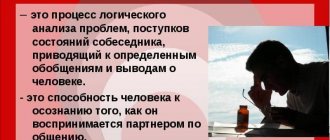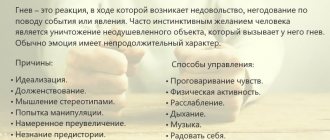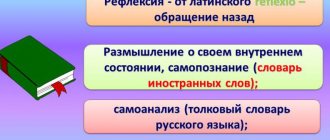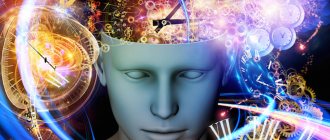Each of us has the ability to direct attention inside our being, to be aware of our thoughts, states, moods and sensations. With this ability we can see ourselves from the outside. In addition, this ability has important practical significance, because it serves as a means of complete and effective self-analysis, allowing you to evaluate your own thoughts, actions and actions, analyze them and change them. This ability is called reflection.
What is reflection and reflexivity
“Reflecto” translated from Latin means “return back.” The same term in French sounds like “reflexio” and means “thinking, reflection.”
Initially, the concept of reflection appeared in philosophy as a tool for observing the external world and a way of understanding human existence.
Through the analysis of phenomena occurring in nature and society, a person gets to know himself, seeks ways for survival and self-improvement. Today, the process of reflection is studied and used in other fields, in sociology and psychology. Reflection is a person’s look inside himself, analysis of his thoughts and actions and rethinking them.
But this process is not thoughtless, but based on acquired knowledge and experience, examined through one’s own mistakes. In addition, in sociology it is the ability to evaluate other people and make comparisons between them and oneself.
Reflexivity is the ability to analyze oneself, identify the motives of one’s own actions, including:
- past actions and events;
- successful or unsuccessful performance results;
- emotional state;
- personality traits and character that change over time.
The degree of reflection is different for each person and depends on the level of knowledge, intelligence, and upbringing. Some people constantly think about their actions and their motives, while others don’t think about them at all. An important role in this is played by a person’s desire to realize his misconceptions and mistakes, the ability to self-criticize and the need to compare himself with the people around him.
Five areas of team lead development
To summarize the above, the team lead has 5 areas of development:
- Execution/GTD. Focus on the performance of the individual employee. If the team leader sees that there is a person on his team who does not perform, then he either does the work for him or, as a supervisor, monitors the performance. The manager’s work efficiency is extremely low (1:1) - he actually replaces the executive level.
- Knowledge/Competencies. Develop professional competencies in the team. In this case, the manager’s effectiveness is much higher and amounts to a conditional 1:3. If you develop knowledge and competencies, you can work with a team of 3 to 10 people.
- Goals/regulations. Identify systematic phenomena, formulate regulations, standards and algorithms at the level of management management. The effectiveness of the manager, that is, the time spent on the result, is conditionally 1:5. It can be significantly higher - 1:10, depending on the company.
- Values/Meanings . Transform the system based on market requirements, develop customer-centricity. This level of responsibility and this direction is the real work of a leader - a manager.
- Team development. The highest level is what you need to strive for in the work of a team lead.
Come to Saint TeamLead Conf on September 23 and 24 in St. Petersburg, we will continue the topic and look at some patterns of behavior in teamwork. Let's talk about when leadership can look like toxicity and vice versa, and how a team leader should approach organizing teamwork to solve complex problems (as opposed to working with tasks).
Reflection in psychology
A sign of a mature person is the ability to accept responsibility for her actions and the life she has. If a person constantly blames others and circumstances for what happens to him, he is considered weak. Changing your worldview can be difficult.
Reflection in psychology is used precisely for such purposes. As a separate, independent topic in psychology, reflection was highlighted by A. Busemann. This scientist suggested that this process is nothing more than the transfer of circumstances of the external world to oneself.
In Russian science, the problems of reflection were studied by such scientists as L.S. Vygotsky, S.L. Rubinstein, B.V. Zeigarnik. In their opinion, the basis of the concept is thinking, leading to self-understanding, the ability to find the motivation for one’s actions, and answers to questions about personal characteristics. Scientists first defined reflection as an opportunity to “learn the truth about oneself.”
Today, reflection is one of the main directions in psychology used to expand the client’s consciousness. For example, if a person is stressed due to negative daily thoughts, but does not understand this, then he will not be able to get rid of his bad mood. In this case, it is possible to stop suffering only by understanding the underlying cause of the decadent mood, and by determining steps to eliminate it.
With a conscious decision, you can stop the flow of unnecessary thought forms and accept yourself in the “here and now” state. The specialist encourages you to look at yourself “from the outside,” as if at the hero of a series on a TV screen. The goal of a good psychologist is to teach independent introspection and obtain answers to nagging questions. Within psychology, reflection and introspection are identical concepts.
When analyzing a certain situation or action, it is necessary to realize and work through the following points:
- A person’s sense of self at the current moment in time. What he experiences: anger, fear, shame, guilt, resentment, etc.
- A weak point in self-awareness that has been damaged by events that have occurred. For example, inflated expectations regarding the behavior of a spouse or other family members, which led to resentment.
- The ability to use the situation, as well as the difficulties that arise, to your advantage.
Reflection promotes understanding of how a person is perceived from the outside, and not just for self-analysis. The result of reflectivity is self-analysis, the formation of desired personal characteristics, and an understanding of the connection between actions and results.
Psychological reflection functions in the following directions:
- Consciousness control, which includes awareness of one’s own thoughts and actions. Formation of logical thinking.
- Understanding your strengths and weaknesses is self-criticism. The ability to recognize the relationship between current events, successes, failures and actions taken.
- Finding the keys to solving complex problems and tasks. The ability to plan your steps to achieve goals.
- Getting rid of destructive, destructive attitudes and thought forms.
- Finding opportunities to make thoughtful, correct, useful decisions.
- Accumulation and identification of latent abilities, talents and resources.
There is an opinion in psychology that reflection is not always good. In practice, there are cases when soul-searching and excessive thinking led to negative consequences (“woe from mind”, “many knowledge, many sorrows”). For this reason, it is important to learn to reflect competently, preferably accompanied by an experienced specialist.
Interesting ways to conduct reflectionmaterial on the topic
Interesting ways to conduct reflection in primary school. (from the work experience of O.S. Gopanovich)
“He who has managed to reflect on reality receives advantages in moving forward” Evgeniy Domansky The concept of reflection. The priority goal of the modern educational concept has become the development of an individual ready for self-education, self-education and self-development. In this regard, one of the tasks of education is to develop in a child the ability to reflexively control his activities as a source of motive and ability to learn, cognitive interests and readiness for successful learning. The word reflection comes from the Latin reflexior - turning back. The Dictionary of Foreign Words defines reflection as reflection, self-control, self-knowledge. This is a form of theoretical human activity aimed at understanding his own actions and their laws. The explanatory dictionary of the Russian language interprets reflection as thinking about one’s internal state, introspection. In social psychology, reflection is the individual’s awareness of how he is perceived by his communication partner. And finally, in modern pedagogical science, reflection is usually understood as self-analysis of activity and its results. Reflection (from Latin reflexio - turning back) - students’ analysis of their own state, experiences, thoughts after completing an activity. This is an attempt to reflect what happened to my “I”: What did I think? How did you feel? What did you buy? What surprised me? What did I understand and how did I build my behavior? and so on. Reflection allows you to accustom the student to self-control, self-esteem, self-regulation and the formation of the habit of understanding events, problems, and life. Reflection contributes to the development of critical thinking in students, a conscious attitude towards their activities, as well as the formation of self-management.
Classification of reflection. 1. By content: • Oral reflection • Written reflection. 2. By purpose: • Reflection of emotional state • Reflection of activity • Reflection of content. 3. By function: • personal reflection (physical, spiritual, sensory) • intellectual reflection. 4. By type of lesson: • After mastering the zun • Intermediate reflection • Control reflection • Final reflection. 5.By methods of conducting: • Questionnaire • Question • Symbol • Table • Situation • Drawing. 5. By form of activity: • Frontal (selective) • Individual • Group • Collective
Functions of reflection in the pedagogical process:
1. Diagnostic 2. Design 3. Organizational 4. Communication 5. Meaning-creating 6. Motivational 7. Corrective.
The more a person knows about what has already been done, the more able he is to understand what needs to be done next. B. Disraeli
Stages of teaching reflection
Stage 1 – analysis of your mood, analysis of your successes Stage 2 – analysis of the work of classmates Stage 3 – analysis of the group’s work
Recommendations.
Reflection associated with the subject’s exploration of himself, the result of which is a rethinking of himself and his relationships, is called personal. Such reflection reflects the human essence: physical (had time - didn’t have time, easy - hard), sensory (well-being: comfortable - uncomfortable, interesting - boring), intellectual (what I understood, what I realized - what I didn’t understand, what difficulties I experienced), spiritual ( became better or worse, created or destroyed himself and others).
It should be borne in mind that spiritual reflection allows only a written, individual form of verification without publicizing the results.
Conducting reflection on mood and emotional state is advisable at the beginning of the lesson in order to establish emotional contact with the group and at the end of the activity.
Reflection on activity makes it possible to comprehend the ways and techniques of working with educational material and searching for the most rational techniques. This type of reflection is acceptable at the stage of checking homework and defending project work. The use of this reflection at the end of the lesson makes it possible to evaluate the activity of everyone at different stages of the lesson.
Reflection on the content of educational material is used to identify the level of awareness of the content of the material covered. It is effective to use an unfinished sentence, thesis, selection of an aphorism, assessment of the “increment” of knowledge and achievement of goals.
Reflection techniques. Reflection of activity. • What impressed you the most? • Will the knowledge acquired in this lesson be useful to you in later life? • What new did you learn in the lesson? • Think about what you need to change to work better? * What am I doing? * why am I doing this? * how do I do? * what new did I learn? * how did I find out? * what have I learned?
“Sun” A circle from the sun is attached to the board, rays of yellow and blue colors are distributed to the children. The rays need to be attached to the sun: yellow - I really liked the lesson, we received a lot of interesting information; blue - the activity was not interesting, there was no useful information.
“Apple tree” An apple tree is drawn on the board. Children are given drawn apples of two colors - red and green. They glue apples onto the apple tree: green - I think I did everything perfectly, I’m in a good mood; red - I didn’t cope with the task, I’m in a sad mood.
“Target” Children fill out a “reflective target” on the board, evaluating 1. their own activities 2. the teacher’s activities 3. the students’ activities.
“Tree of Predictions” The rules of work are as follows: the trunk of the tree is the topic, type of activity, the branches are statements that are carried out in the directions - “yes” and “no” (the number of “branches” is not limited), and the “leaves” are the rationale for these statements ( arguments in favor of this or that opinion, names, assessments, results, etc.)
“Thermometer” Using such a symbol, you can determine the state of emotions, the novelty of the material, lesson, originality, etc.
"Apple and Arrows"
“Levels” Using this symbol, you can determine at what level the students completed the tasks, what level their self-esteem corresponds to, etc.
“Peak of Mutual Understanding” The mood is depicted as a step. The first one is an extremely bad mood. The second is bad. The third is good. Fourth - I am confident in my abilities. Fifth – excellent. At the end of the lesson, the day, the student puts himself on the level of what his mood is.
“Stars” On “star” symbols, students write down their personal achievements in a lesson, for a week, a quarter, etc. and attach them to a diary, on a stand, on a board, etc.
“Basket of ideas” Students write down their opinions about the lesson on pieces of paper, all the pieces of paper are placed in a basket (box, bag), then the teacher selectively reads out the opinions and discusses the answers. Students express their opinions on pieces of paper anonymously.
“Faces” Reflection on the emotional state, can be used at various stages of the lesson. Students draw “faces” that match their mood or choose from the available ones.
“Sunny” Reflection on the emotional state, can be used at various stages of the lesson. Students are asked to choose a sun that matches their mood.
“Tree” Students write down their opinion about the lesson on paper in the shape of tree leaves, you can propose a series of questions, then attach them to the blank tree on the poster.
“Traffic light” At the beginning of the lesson, students choose one of the colors: red, yellow or green. After a lesson or completed work, the children must express their opinion on the issue of color. Red – no (what you didn’t like, mistakes), yellow – not really (doubts, difficulties) and green – yes (what you liked, what worked).
“Pyaterochka - 1” Students are asked to circle their hand on a piece of paper. Each finger is some kind of position on which you need to express your opinion. The thumb is important and interesting for me; Index finger - it was difficult for me (I didn’t like it); Medium – wasn’t enough for me; The ring finger is my mood; Pinky - my suggestions.
“Pyaterochka - 2“ In order for students to evaluate their activity and the quality of their work in the lesson, I suggest that the children conditionally mark their answers on a piece of paper: “V” - answered at the request of the teacher, but the answer is not correct “W” - answered at the request of the teacher, the answer is correct " | " - answered on his own initiative, but the answer is not correct "+" - answered on his own initiative, the answer is correct "0" - did not answer. By discussing the results of their observations at the end of the lesson, students will be able to objectively assess their activity and quality of work.
“Elephant” Students are given a piece of paper to draw an elephant. The leaves are collected by the teacher for further analysis of the student’s work in the lesson. Students are then verbally given characteristics of the elements. Ears means a person listens carefully, perceives more by ear; eyes - looks carefully, perceives more visually; trunk - the knowledge you acquire; the head is thought processes; look at the relationship between the head and the body: a large head - the author of the drawing uses his head more; thin legs - uncertainty.
“Mood Map” At the end of the lesson, the children fill out cards of their emotional state, in which they note their well-being, indicate their attitude to the lesson, writing down what they liked (didn’t like) during the lesson.
“It’s in the Hat” Students pass the hat to each other, when the music or counting ends, the one who still has the hat in his hands analyzes his work in the lesson or gives a grade to those working at the blackboard and justifies it.
“Plus - minus - interesting” Reflection can be carried out orally at the board, where students selectively express their opinions at will; they can be divided into rows into “+”, “–”, “?” or individually in writing. This chart was created by Edward de Bono, M.D., Ph.D., University of Cambridge, a specialist in the development of practical thinking skills. This exercise allows the teacher to look at the lesson through the eyes of the students and analyze it in terms of value for each student. For students, the most important columns will be “P” and “I”, since they will contain reminders.
“+” “–” “?”
All facts that caused positive emotions are recorded in the “+” column. In the “–” column, students write down everything that is missing or remains unclear. In the “interesting” (?) column, students write down everything they would like to know more about, what interests them.
“Sinquain” This is a method of creative reflection that allows you to evaluate the studied concept, process or phenomenon in an artistic form. In this case, information is not only more actively perceived, but also systematized and evaluated. The word comes from the French “5”. This is a poem of 5 lines, which is built according to the rules: 1 line - topic or subject (one noun); Line 2 – description of the item (two adjectives); Line 3 – description of the action (three verbs); Line 4 – a phrase expressing an attitude towards the subject; Line 5 – a synonym that generalizes or expands the meaning of a topic or subject (one word).
“Key words” The “key words” of the lesson are attached to the board, using which you can come up with a story or arrange them in a certain sequence. For example words: assessment, task, neighbor, teacher, etc.
“Expert Commission” At the beginning of the lesson, experts are selected (students who did an excellent job on the test). They record the students’ activities (row, option) throughout the lesson. At the end of the lesson, experts analyze the activities of their students, indicate successes and mistakes, and give them grades.
“10 points” Rate the work in class on a 10-point scale from the position: “I” 0________10 “We” 0________10 “Business” 0________10
“Today’s lesson for me...” Students are given an individual card in which they need to underline phrases that characterize the student’s work in the lesson in three areas.
Lesson I'm in class Result 1. interesting 1. worked 1. understood the material 2. bored 2. rested 2. learned more than I knew 3. indifferent 3. helped others 3. didn’t understand
At the end of the lesson, you can give the children a short questionnaire that allows them to carry out self-analysis and give a qualitative and quantitative assessment of the lesson. Some points can be varied and supplemented, it depends on what elements of the lesson you pay special attention to. You can ask students to justify their answer. 1. I worked in the lesson 2. My work in the lesson I 3. The lesson seemed to me 4. For the lesson I 5. My mood 6. The lesson material was for me
7.Homework seems to me active / passive satisfied / not satisfied short / long not tired / tired became better / became worse understandable / incomprehensible useful / useless interesting / boring easy / difficult interesting / not interesting
“Tomorrow test” Taking an essay before a test or independent work, in order to identify students’ readiness, gaps in knowledge, and their experiences. For an essay, you can prepare questions in advance.
“Pantomime” Students must use pantomime to show the results of their work. For example, hands up - happy, head down - not happy, covering your face with your hands - indifferent. “Logbook” From (English Log) - a form of recording information using keywords, graphic models, short sentences and conclusions, questions. The parts of the “logbook” set by the teacher that will be filled out by students may include: key concepts of the topic, connections that the student can make, important questions.
“Two-part diary” In one column - the subject of reflection, in the other - comments. The diary is kept over a long period of time and allows the student to carry out more thoughtful reflection, tracking both the immediate process and comparing their actions over time. For example, tracking test results.
Work Result
“Written interview” A variant of group written reflection in the form of questions and answers from group members. This method allows you to conduct written reflection in a fairly short period of time for the purpose of mutual exchange of opinions.
“Compliment” In order to end the lesson on a positive note, you can use one of the options for the “Compliment” exercise (Compliment-praise, Compliment on business qualities, Compliment on feelings), in which students evaluate each other’s contribution to the lesson and thank each other and the teacher for lesson taught. This option for ending the lesson makes it possible to satisfy the need for recognition of the personal significance of everyone.
“Clusters” Identification of semantic units of text and graphic design. We draw a model of the solar system: a star, planets and their satellites. In the center there is a star - this is our lesson, around it there are planets - parts of the lesson or task, we connect them with a straight line to the star, each planet has its own satellites - the results of the work. Based on the finished cluster, you can see the whole picture of the lesson and draw appropriate conclusions. The star can be a topic, student work in groups, a test, or a teacher in a lesson. The results can be assessments, suggestions, difficulties, successes.
“Prohibition” technique This technique is used when students reduce their thoughts about themselves and current events to the phrases: “I can’t...”, “I don’t know how...”, “I won’t be able to...”. Students are prohibited from saying “I don’t...”, but are asked to express the same thought in other words: what is needed to make it happen; what funds would be necessary to have for...; what skills do I need for this; what additional information do I need for this, etc. In the implementation of this technique, the student’s passive behavior is transformed into directed reflection on his experience.
“Bouquet of mood” At the beginning of the lesson, the children are given paper flowers: blue and red. At the end of the lesson, the teacher says: “If you liked the lesson and learned something new, then attach a red flower to the vase, and if you didn’t like it, then a blue one.”
You can offer children a wider range of colors: red, yellow, blue. At the end of the lesson, collect the flowers in a basket or vase.
Emotionally - artistic reflection. Students are offered two paintings of a landscape. One picture is imbued with a sad, melancholy mood, the other – with a joyful, cheerful one. Students choose the picture that matches their mood.
Emotional – musical reflection. Students listen to fragments from two musical works (it is advisable to indicate the composer of the work). There is alarming music and calm, enthusiastic music. Students choose a piece of music that matches their mood.
"What are you feeling now?"
Students in grades 3 and 4 can evaluate not only their mood, but also their emotional state. And the questions “How are you feeling now? What emotions are you experiencing? They quickly become familiar and do not surprise the children. To help students make their statements, we offer a supporting outline, which also helps expand their vocabulary.
“Reflective screen” Usually at the end of the lesson there is a summary, a discussion of what we learned and how we worked - i.e. everyone evaluates their contribution to achieving the goals set at the beginning of the lesson, their activity, the effectiveness of the class, the fascination and usefulness of the chosen forms of work. The guys in a circle speak in one sentence, choosing the beginning of a phrase from the reflective screen on the board: 1. today I learned... 2. it was interesting... 3. it was difficult... 4. I completed the tasks... 5. I realized that... 6. now I can ... 7. I felt that... 8. I acquired... 9. I learned... 10. I succeeded... 11. I was able... 12. I will try... 13. I was surprised... 14. He gave me a lesson for life... 15. I wanted... Evaluate your feelings in phraseological terms: - porridge in the head - no kick in the tooth - bright head of the “Island” The guys choose which of the proposed islands they are on at the end of the lesson: the island of Satisfaction, the island of Sadness, the island of Knowledge, the island of Joy.
A.M.O. “Restaurant” Purpose: Find out and get feedback from students from the last lesson. Time: 5 min. for preparation; 1-3 min. each participant (for response). Number of students: All students Materials: large format sheet, markers, tape, colored cards
Conduct: The teacher invites the students to imagine that they spent today in a restaurant and now the restaurant director asks them to answer several questions: - I would eat more of this... - I liked it most... - I almost overcooked... - I overate... - Please, add... Participants write their answers on cards and stick them on a flip chart sheet, commenting.
Note: For the teacher, this stage is very important, because it allows you to find out what the children have learned well and what needs to be paid attention to in the next lesson. In addition, feedback from students allows the teacher to adjust the lesson for the future. At the end, the teacher summarizes the lesson, gives homework if necessary, and finally says good words to the children. This is how a lesson using AMO will go unnoticed, fun, but effectively, bringing satisfaction to both the teacher and students.
A.M.O. “Fly agaric” A circle is drawn on a sheet of paper, which is divided into sectors according to the number of stages of the lesson. Questions are written outside the circle. For example, with a general topic of discussion, the question is asked “How satisfied was I …” • with the delivery of content • the opportunity to ask questions • the psychological atmosphere in the group • distributed work and information materials • organization of recreation Before starting work, you are given the opportunity to indicate your assessment by sticking circles on sectors of the circle or drawing felt-tip pen. The greater the satisfaction, the closer to the center of the circle the icons are placed (association - hitting the target). The general appearance of the “fly agaric” reveals the main trends in assessing work in its individual aspects. Next, a general discussion of the results is carried out with clarification of individual points. Note: This method is vulnerable because many tend to join the estimates of their predecessors. Therefore, you need to make sure that the placement of icons in a circle does not take place in front of all participants, but, for example, on a stand turned backwards.
A.M.O. "Hims"
Purpose: Find out and get feedback from students from the last lesson. Time: 15 min. Number of students: All students Material: large format sheet, felt-tip pens. Conducting: This method helps to find out impressions of a lesson or seminar on the following issues:
• Good... • Interesting... • Interfering... • I'll take it with me...
Each participant must answer questions frankly, including questions about their well-being, which also affects the productivity of work in the lesson.
A.M.O. “Everything is in my hands” Goal: Find out and get feedback from students from the last lesson. Time: 5 min. for an explanation; 10-20min. for individual work; 15 minutes. to view the exhibition Number of students: All students Material: large format sheet, felt-tip pens. Conduct: Questions to check the results of work are indicated using fingers: • Thumb - I would like to work on this topic more; • Index – here I was given specific instructions; • Average – I didn’t like it here at all; • Nameless – psychological atmosphere; • Little finger – I missed it here. Participants draw their hand on a piece of paper, tracing an outline, write down questions next to each finger and write the answers to these questions inside the outline. Then the sheets are posted on the exhibition and all participants are given time to get acquainted with it before the general discussion.
A.M.O. “Cleaning the house” Purpose: To find out and receive feedback from students from the last lesson, each participant to determine what was useful and what was useless. Time: 15 min. Number of students: All students Materials: three large format sheets with drawings, felt-tip pens. Carrying out: Three large sheets of paper are attached to the wall; the first one shows a suitcase, the second one shows a trash can, and the third one shows a meat grinder. Each participant receives three colored pieces of paper. On the “suitcase” the participant writes what he took away from the lesson or seminar, will take with him and will actively use. On the second sheet is what turned out to be useless, unnecessary and what can be sent to the trash. On the third sheet is what turned out to be interesting, but is not yet ready for use, what still needs to be thought out and finalized.
Literature 1. Abramov A., Bim-Bad, B., Gromyko, Yu. What is a basic component [Text] / A. Abramov, B. Bim-Bad, Yu. Gromyko // Teacher’s newspaper. – 1988. – December 17 . (No. 149).– P. 2. 2. Alekseev N.G. The ability to reflect as an essential component of the intellectual culture of a modern specialist [Text] / N.G. Alekseev // Problems and methods of forming the intellectual culture of a specialist. – Novosibirsk, 1984. – P. 100-102. 3. Bogin V.G. Several aspects of the problem of school education and some thoughts on ways to solve it / V.G. Bogin // Questions of methodology. – 1999.– No. 1-2. –C. 35-54. 4. Bogin V.G. Teaching reflection as a way to form a creative personality [Text] / V.G. Bogin // Modern didactics: theory - practice / ed. AND I. Lerner, I.K. Zhuravleva. - M., 1993.. 5. Kraevsky V.V., Khutorskoy A.V. Subject and general subject in educational standards [Text] / V.V. Kraevsky, A.V. Khutorskoy // Pedagogy. – 2003. – No. 2. – P. 3-10. 6. Kuzmina N.V. Teacher’s pedagogical skill as a factor in the development of students’ abilities [Text] / N.V. Kuzmina // Questions of psychology. – 1984. – No. 1. – P. 20-26. 7. Theoretical foundations of the content of general secondary education [Text] / ed. V.V. Kraevsky, I.Ya. Lerner. – M., Pedagogy, 1983. – P. 352. 8. Khutorskoy A.V. Activity as the content of education [Text] / A.V. Khutorskoy // Public education. – 2003. – No. 8 – P. 107-114. 9. Shchedrovitsky G.P. Selected works. [Text] / G.P. Shchedrovitsky – M.: School of Cultural Policy, 1995. – P. 133-138. 10. Shchedrovitsky G.P. Communication, activity, reflection. [Text] / G.P. Shchedrovitsky // Study of speech and mental activity. – Alma-Ata, 1974 11. Novichkov V.B. The eternal question: what to teach today? (Text) / V.B. Newcomers // Pedagogy. – 1988.-No. 8. –P.6-8 12. Elkonin D.B. Selected psychological works. - M.: Pedagogika, 1989. p. 81. 13. Yasvin V.A. Psychological modeling of educational environments. Psychological journal.-2000.-No. 4. 14L.A. Mednikova “Reflective activity of a junior schoolchild” J-l Science and school practice No. 1, 2008
1. Website of the international magazine on critical thinking “Peremena” https://www.ct-net.net/ru/ 2. Festival of pedagogical ideas https://festival.1september.ru/ 3. Newspaper “First of September” https:/ /ps.1september.ru/ 4. Website “My University”
Goal: to increase the motivation of colleagues to master the reflective activities of students.
Tasks:
- Introduce colleagues to the concept of “reflection”.
- Give an idea of the classification of reflection.
- Show specific options for conducting reflection in the classroom.
- Create conditions for active interaction between the master class leader and master class participants.
Progress of the event
Preparation for the master class.
- Distribute cards of a cheerful and sad person to the participants.
- Distribute tables, green and yellow cards.
- Distribute pieces of paper and pencils for making a syncwine.
- Hello, dear colleagues! I am glad to welcome you to my master class.
– Show your mood with an appropriate card. (I show too)
The topic of my Master Class is “Techniques for student reflection in the classroom in elementary school.”
In front of you is a table recording your knowledge, please fill out the second column “I know” on this topic and set it aside.
My goal: Slide 2
To increase teachers' motivation to master students' reflective activities.
What is your goal? (answers)
Slide 3. One parable says: “Once upon a time there lived a wise man who knew everything.
One man wanted to prove that the sage does not know everything. Holding a butterfly in his palms, he asked: “Tell me, sage, which butterfly is in my hands: dead or alive?” And he himself thinks: “If the living one says, I will kill her; if the dead one says, I will release her.” The sage, after thinking, replied: “Everything is in your hands.” In our hands, so that the child feels loved Slide 4
necessary Slide 5
and most importantly, successful. Slide 6
Psychologists especially emphasize that the formation and development of spiritual life is associated, first of all, with reflection.
What is reflection?
Slide 7. Reflection is a person’s reflection aimed at analyzing himself (self-analysis) - his own states, his actions and past events. At the same time, the depth of reflection and self-analysis depends on the degree of education of a person, the development of moral sense and the level of self-control. Reflection, in a simplified definition, is “talking to oneself.” The word reflection comes from the Latin reflexio - turning back. The Dictionary of Foreign Words defines reflection as thinking about one’s internal state, self-knowledge. The explanatory dictionary of the Russian language interprets reflection as introspection. In modern pedagogy, reflection is understood as self-analysis of activities and their results.
A prerequisite for creating a developmental environment in the classroom is the reflection stage. It helps students formulate the results obtained, determine the goals of further work, and adjust their subsequent actions. Reflection is associated with the formation of personal, regulatory and communicative universal educational actions, with the technology of critical thinking.
When interacting with a student, the teacher uses, depending on the circumstances, one of the types of educational reflection, reflecting the four spheres of human essence: Slide 8.
- physical (had time - did not have time);
- sensory (feeling: comfortable – uncomfortable);
- intellectual (what I understood, what I realized - what I didn’t understand, what difficulties I experienced);
- spiritual (became better or worse, created or destroyed oneself and others).
Reflection happens: Slide 9
a) individual - the formation of real self-esteem (for which you can evaluate your work, a conversation with the child based on the results of self-esteem - why this or that level was chosen); b) group – emphasizing the value of the activities of each group member to achieve maximum results in solving the task. (“They would have been able to do it if .... (name) had not worked with us.” “What kind of help did ... (name) provide in the work”).
Traditionally, psychology distinguishes several types of reflection:
- Slide 10 Communicative - its object is ideas about the inner world of another person and the reasons for his actions. Here reflection acts as a mechanism for knowing another person.
- Slide 11. Personal - the object of cognition is the cognizing personality itself, its properties and qualities, behavioral characteristics, system of relationships with others.
- Slide 12. Intellectual - manifests itself in the process of solving various kinds of problems, in the ability to analyze various solutions, find more rational ones, and repeatedly return to the conditions of the problem.
Reflection can be carried out not only at the end of the lesson, as is commonly believed, but also at any stage. Reflection is aimed at understanding the path traveled, at collecting into a common treasury what was noticed, thought out, and understood by everyone. Her goal is not just to leave the lesson with a fixed result, but to build a chain of meaning, to compare her methods and methods with others.
Slide 13. Based on the functions of reflection, the following classification is proposed.
- Reflection of mood and emotional state
- Reflection of activity
- Reflection on the content of educational material
Techniques for reflecting emotional states.
- Slide 14 Cards with a face (sad, happy); showing thumbs up or down.
- Slide 14 “Sunny” - I succeeded in everything, “sun and cloud” - I didn’t succeed in everything, “cloud” - I didn’t succeed.
- Slide 15 “Joyful gnome” - everything is fine, “sad gnome” - sad.
Reflection of activity. This type is acceptable at the stage of checking homework, defending design work; it makes it possible to understand the ways and techniques of working with educational material, to search for the most rational methods, and application at the end of the lesson will show the activity of each student.
- Slide 16 “Ladder of success” - the bottom step, the “little man” has his hands down - nothing worked out for me; middle step, the “little man” has his arms spread to the sides - I had problems; the top step, the “little man” has his hands raised up - I succeeded.
- “Dress up the Christmas tree” - successfully completed the task - hung the ball, there were mistakes - the ball remained near the tree.
- Slide 17 “Tree of Success” – green leaf – no errors, yellow leaf – 1 mistake, red leaf – 2-3 mistakes.
- Slide 18 “Train” On the board there is a train with trailers on which the stages of the lesson are indicated. Children are asked to put the “cheerful face” in the trailer that indicates the task that was interesting to complete, and the “sad face” in the one that symbolizes the task that seemed uninteresting. Only one token may be used at the discretion of the student.
- Slide 19 “Glade”. On the board there is a clearing of flowers, above each flower there is a stage of the lesson (working with text, phonetic exercises, etc.). There is a butterfly in front of every child. You invite the children to attach their butterfly to the flower which activity they liked best.
Reflection on the content of educational material is used to identify the level of awareness of the content covered.
Usually at the end of the lesson there is a summary, a discussion of what we learned and how we worked - i.e. everyone evaluates their contribution to achieving the goals set at the beginning of the lesson, their activity, the effectiveness of the class, the fascination and usefulness of the chosen forms of work. The guys in a circle speak in one sentence, choosing the beginning of a phrase from the reflective screen on the board: Slide 20
- today I found out...
- it was interesting…
- it was difficult…
- I completed tasks...
- I realized that...
- Now I can…
- I felt that...
- I purchased...
- I learned…
- I managed …
- I was able...
- I will try…
- I was surprised...
- gave me a lesson for life...
- I wanted…
Slide 21 “Plus-minus-interesting.” (author Edward de Bono, MD, PhD, University of Cambridge, specialist in the development of practical skills in the field of thinking)
Purpose: summing up the lesson. (This exercise allows the teacher to look at the lesson through the eyes of the students, analyze it from the point of view of value for each student.)
This exercise can be done either orally or in writing, depending on time availability. For written completion, it is proposed to fill out a table of three columns.
In the “P” - “plus” column, everything that you liked during the lesson, information and forms of work that aroused positive emotions, or in the student’s opinion may be useful to him in achieving some goals, is written down.
In the “M” - “minus” column, everything that was not liked in the lesson, seemed boring, caused hostility, remained incomprehensible, or information that, in the student’s opinion, turned out to be unnecessary for him, useless from the point of view of solving life situations, is written down.
In the “I” - “interesting” column, students write down all the interesting facts that they learned about in class and what else they would like to know about this problem, questions for the teacher.
Slide 22 An interesting technique of reflection is in the form of a syncwine (pentament). Cinquain was developed by the American poet Adelaide Crapsey, influenced by Japanese haiku and tanka miniatures. In Russia it began to be used in 1997. Can be used as a final assignment on the material covered.
- first line – topic name (one noun);
- the second is a description of the topic in a nutshell, two adjectives;
- the third is a line describing the action within this topic in three words;
- the fourth line is a four-word phrase that shows the attitude to the topic (a whole sentence);
- the last line is a synonym that repeats the essence of the topic.
In this conclusion, each student combines and generalizes his impressions, knowledge, and imagination.
Markings in the margins (insert, marking) - designation using signs in the margins near the text or in the text itself:
“+” – knew, “!” – new material (learned), “?” - I want to know
Cheat sheet - information, wording, rule, etc. in a compressed form. Drawing up memos, diagrams or texts for reference books.
Ranking, arrangement of concepts in the required order.
Restoration of a deformed statement, rule, text or addition of missing words (for example, when every third or fifth word is missing).
Slide 23 Tablet - recording knowledge and ignorance about a concept
| Concept | Knew | Found out | I want to know |
Slide 24 Cluster (bunch) – fixation of a system concept with interconnections.
The process of reflection must be multifaceted, since the assessment is carried out not only by the individual herself, but also by the people around her. Thus, reflection in the lesson is a joint activity of students and teachers, which makes it possible to improve the educational process, focusing on the personality of each student.
Slide 25. REFLECTION OF THE MASTER CLASS.
You have two cards: green and yellow. If you liked my master class: it was relevant, useful, interesting and you will use it in your work - show me the green card. Well, if all this doesn’t touch you at all, show the yellow card.
Take a card with a recording table, if you have something to add, write it in the third column. Who can read out their table data? (Answers from participants)
Work in groups. Compose a syncwine on the topic of the Master Class. Slide 22.
The syncwines are read out.
Thank you all very much!
Table for listeners.
| Concept | I know | Found out | I want to know |
| Reflection |
Sources:
- images.yandex.ru/?lr=53 Pictures
- it-n.ru ›attachment.aspx?id=105334
- A.V. Khutorskoy. Analysis, introspection and reflection of the lesson khutorskoy.ru/be/2008/0312/index.htm
- Golovkina Ekaterina Vyacheslavovna. Summing up the lessons. Reflection. ezhva-licey.ru/teachers/nmr/metodich_razrabotki/itogi_uroka/
- Gukalova Irina Viktorovna. The role and place of meaningful reflection in the classroom. kollegi.kz/publ/21-1-0-93
Share... I need to work on myself
Everything worked out for me today, I didn’t make any mistakes.
I can find solutions with the help of a teacher
Concept of self-reflection
Self-reflection is often identified with reflection. This is partly true. The difference between the concepts is that the prefix “self” indicates a reflection of oneself, and not just the external world, events and other people.
Self-reflective people constantly listen to their own feelings and emotions and try to analyze them. Such exercises are very useful for understanding your own self, personal desires and needs. How often do we focus on the expectations of other people, looking for an assessment of our actions from the outside. As a result, one’s own dreams and internal needs remain unfulfilled.
Young people enter training in prestigious professions, and their souls are drawn to creative delights. As a result, the profession does not bring satisfaction, but the parents are happy! A person lives an uninteresting life, suppressing existing talents.
There is another side. In hypertrophied cases, a person constantly listens to emotions. He becomes fixated on personal experiences and becomes neurotic, not seeing the outside world, which is beautiful. A person stops enjoying life, constantly analyzing his own condition.
In this case, it is important to get out of yourself in time, take a deep breath, feel material things: table, floor, wall, hands, feet, sounds and smells.
Many people are wary of their own body signals. Often, excessive reflection leads to neurotic diseases, for example, hypochondria (a pathological condition in which we find ourselves with all possible and impossible diseases).
Cases have been recorded when women find all the signs of pregnancy, and only the results of repeated laboratory examinations (for example, ultrasound) can dissuade them from this. Of course, if you suspect a disease, you must undergo a medical examination. But when a person realizes that his fears are far-fetched, he should move away from focusing on personal feelings and ignore them.
Forms and types of reflection
We described reflection as a complex process directed both within oneself and into the external world, leading to benefit for the individual, or, on the contrary, to its destruction. Let's consider what forms and types of introspection exist in psychology.
From the point of view of the impact on the future state of a person:
- Correct constructive self-analysis, which allows you to understand yourself, draw logical conclusions and not step on familiar mistakes again.
- Harmful destructive self-analysis, leading to neurotic disorders and deep fixation on problems, often imaginary. In such situations, feelings of guilt, helplessness and hopelessness are cultivated. A person needs the help of a specialist.
Taking into account time periods, reflection occurs:
- Event-based or situational . The individual analyzes a problem that takes place in the present time, “here and now.”
- Retrospection , looking to the past. A person evaluates past events and his actions, draws conclusions about their correctness and timeliness.
- Perspective , facing future events. The individual plans further actions and events based on self-analysis.
Based on the object of study, the process can be divided into the following forms:
- Self-reflection , turning to one’s own inner world, personal experiences and emotions.
- Communicative . In this form, reflection is devoted to other people, interaction with friends, relatives, and colleagues. A person tries to analyze relationships and interactions.
- Sanogenic is a type of self-analysis in which a substantive study of strong emotions is carried out, a search for means to minimize or eliminate unnecessary suffering and experiences.
- Intelligent . The individual’s attention is focused on the application of knowledge, skills, and the possibilities of their use in the material world.
A combination of forms of reflection under given conditions gives the best results; it is always necessary to combine methods of analysis for a specific situation.
What does it mean to reflect?
To reflect is to think, to think logically, to analyze actions and actions, to know oneself.
Is it worth understanding your personality? Of course yes. If a person has not understood himself, he is led by others and lives someone else’s life. Low self-esteem, complexes, and feelings of guilt sit deep inside and interfere with further development. They need to be found and neutralized.
By reflecting, we learn:
- Think rationally.
- Stop mental “garbage”.
A low level of self-analysis is the path to making the same mistakes and blunders throughout your life. At the everyday level, the concept of a reflective person is often associated with such definitions as: “to be nervous”, “to worry”, “to worry too much”. Therefore, in any action, moderation and reasonableness are important.
It is necessary to approach your inner world soberly and calmly, without allowing emotions to overwhelm the arguments of reason. A person who knows how to reflect is his own psychoanalyst; not everyone is capable of this.
In order to “self-examine” for the benefit of your business, you need to avoid the following mistakes:
- You should think about the motives for your actions, not the actions themselves . For example, a husband who cheated on his wife may realize his betrayal and vow not to do it again. But if a man does not understand what pushed him to cheat, no force will stop him from repeating the mistake, since the motives for the need to go “to the left” will remain undeveloped.
- “Saw sawdust ,” as D. Carnegie said. This means constantly grinding past sins and failures in your head, coming up with possible other consequences of what has already happened. What was is no longer there, think about the current moment, make plans for the future.
- Cultivate feelings of guilt . Yes, we made a mistake, but we got our lesson for it. There is no point in berating yourself for something that cannot be fixed. Everything is not without sin.
- Responsible for the whole world . Processes in the world occur against our will. We should not take responsibility for something we cannot influence.
If you follow the rules outlined, then reflection is not only possible, but also useful.
How to develop reflection
The best way to learn a skill is to start practicing it. To develop reflection, you need to start practicing it.
How to do it?
- Try to understand what feelings you are experiencing at the current moment. The habit of being attentive to emerging joy, anger, melancholy and connecting them with ongoing events or communications with certain people.
- Monitor stories in which you react too harshly, painfully. If certain events hit you particularly hard, you need to understand what the trigger is.
- If you notice that in the process of thinking about something you experienced melancholy or painful emotions, then it is better to stop soul-searching and return to the roots of the problem a little later. Highly sensitive people cannot do without the help of a specialist.
- Give up total control of reality. Reflection is not a reason to put the material world into pieces. Allow life to flow outside of your participation.
- In the evening, you can “scroll” your day in your head, all its pros and cons, and form plans for tomorrow.
- To develop reflection, make it a rule to think systematically about any phenomenon or object that interests you.
After gaining reflection skills, you can ask yourself a few questions and give honest answers to them:
- Think about whether there is something in the past that would be worth returning to and trying to start over. This could be family, work, hobbies, friends, etc. Sometimes a return to the past means the beginning of a new stage.
- Clearly establish for yourself what brings pleasure and makes you happy. This will be the strategic goal to which you should devote your future life.
- If you are not happy with the point you are in now, determine the actions you need to take to get out of it. Do not slip into self-flagellation or attribute all problems to external circumstances.
- Truthfully answer the question of what you are doing wrong. You should not wring your hands with the question: “Why do I need this?” Take responsibility for failures personally. Where was the mistake, the flaw? The truth can be unpleasant, but without it it’s difficult to fix anything.
- If you fail at a question, analyze whether everything possible has been done or whether you can try something else.
- Analyze actions from the point of view of achieving the goal. This does not mean that you cannot be spontaneous and that you need to think through every step. However, when time is short, prioritization becomes necessary.
There is an opinion that the purpose of life is life itself, getting pleasure from it and those things that correspond to our internal needs. Reflect wisely, achieve what you want and be happy!
Team development
In order to understand who occupies what roles in group work, let’s turn to the analytics obtained on the Seendex platform based on large-scale studies of the behavior of employees of Russian organizations in a situation requiring development.
The picture is as follows:
- 72% of people have no attitude towards development; they don’t really need it. They live and live, work somehow, earn money and don’t think about development at all.
- Only 1% of people, let's call them leaders, always strive for development - they constantly need something, they constantly change something, study something.
- The remaining 27% behave situationally: if there is a leader, they follow him, if not, they join the non-developing majority.
That is, if an organization has a strong leader, then the whole company develops, new projects and interesting tasks appear, people change, their standard of living is constantly growing, their salaries and influence increase. If there is no such leader, then these 27% join the majority, act like everyone else, and everything for them moves steadily, without development.
From a management point of view, in almost any team you can find all categories of employees.
There is a very simple rule in team development: you can develop those who are developing.
You cannot force a person to develop; most people (72%!) do not need this. If we talk about the value of reflection, not everyone needs it - not everyone understands it and not everyone can be involved in it. When you manage a team, look at who is in front of you, act situationally for reasons of common sense . In this sense, there is no need to try to make all people happy, because it will not work.
There will always be people on the team who simply work for results. Next we will see what to do with this. And there are people who look to the future. Now they may achieve good results or not so much, but they are developing and will become better and more productive in the future.
Unfortunately, in Russian there is no suitable word equivalent to performance. Productivity, for example, does not fully convey the semantics of a word. Therefore, I will leave performance in the empirical formula:
The denominator is resources, and an important component of them is the manager’s brain, which is especially important in today’s management realities.
Thus, there are always people on the team who are not ready to change. It is important to understand how they work as a team and what motivates them.
There are several accepted types, for example, a service person . This is quite surprising, but nevertheless such a concept exists and is being actively studied. This is the most unreflective and unconscious type of people. Fortunately, I think there are few such people in development teams. An official person works exclusively in strict management conditions, he needs a context: goals, tasks, execution, a fixed work schedule, an overseer (supervisor). This type of people was popular until the 20th century - from slave times to the beginning of active work with machines.
An executive person already does as he was told . Generally speaking, not everyone has this property, because sometimes we like to do things the way we like best, or we think that “it will be better this way,” and not the way we were told.
The next stage in the development of an unconscious person is a motivated person . It works well with KPIs and with such a well-motivating thing as salary: do more - get more, do less - get less. Other simple motivations also work here.
The person involved needs an idea, a meaning to the work. It will work well if there is an interesting project, an interesting movement, a good team or company. Fortunately, there are many such people in IT teams.
In general, it seems that there are almost no service and executive people left in IT, and motivated and involved people are a common practice.
To take a step towards team development, let's turn to the concept of norm.
On the graph, the vertical line shows the number of employees in the team, and the horizontal line shows performance according to the formula.
We live in an age of continuous innovation, improvement and acceleration. This was not the case 20 years ago, but now the company cannot survive without constant development. Conventionally, every day you need to do something and come up with a new norm.
The graph shows the old norm (on the left) and the new norm (on the right). It turns out to be a simple formula: to get into the new normal, you need to do two things:
- leave those who have high performance, that is, are in the highest (right) part of the old norm - constantly demonstrate outstanding results;
- develop those who develop.
Team development becomes an integral part of the team lead’s work.
In relation to the norm, there is an expression: “Only a reflected action can acquire a norm!” It is impossible to simply move from raw accumulated experience to a new normal. Experience needs to be reflected on.











